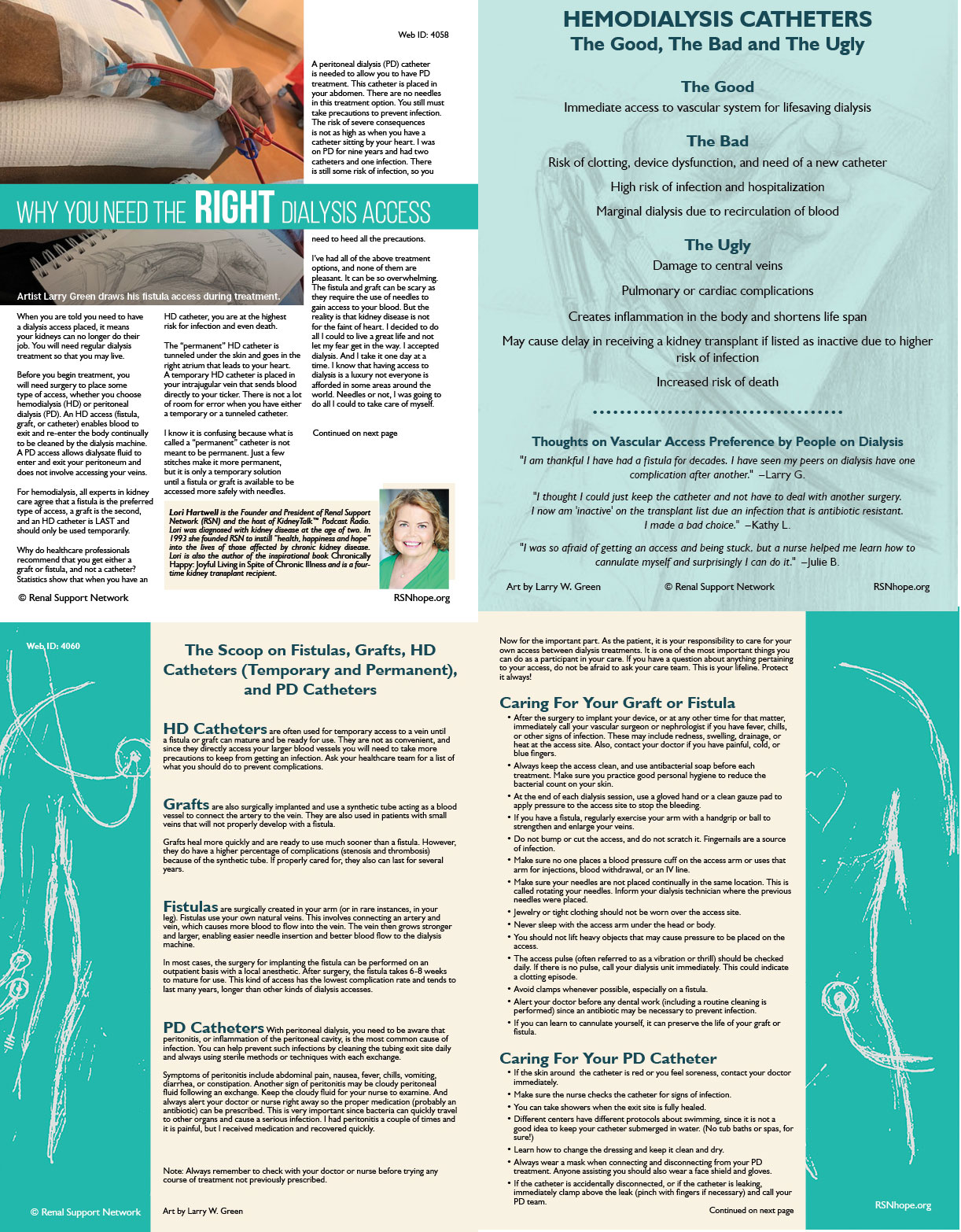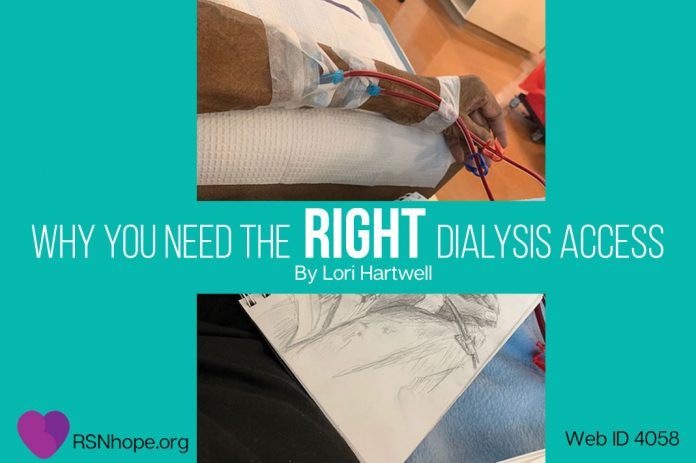When you are told you need to have a dialysis access placed, it means your kidneys can no longer do their job. You will need regular dialysis treatment so that you may live.
Before you begin treatment, you will need surgery to place some type of access, whether you choose hemodialysis (HD) or peritoneal dialysis (PD). An HD access (fistula, graft, or catheter) enables blood to exit and re-enter the body continually to be cleaned by the dialysis machine. A PD access allows dialysate fluid to enter and exit your peritoneum and does not involve accessing your veins.
For hemodialysis, all experts in kidney care agree that a fistula is the preferred type of access, a graft is the second, and an HD catheter is LAST and should only be used temporarily.
Why do healthcare professionals recommend that you get either a graft or fistula, and not a catheter? Statistics show that when you have an HD catheter, you are at the highest risk for infection and even death.
The “permanent” HD catheter is tunneled under the skin and goes in the right atrium that leads to your heart. A temporary HD catheter is placed in your intrajugular vein that sends blood directly to your ticker. There is not a lot of room for error when you have either a temporary or a tunneled catheter.
I know it is confusing because what is called a “permanent” catheter is not meant to be permanent. Just a few stitches make it more permanent, but it is only a temporary solution until a fistula or graft is available to be accessed more safely with needles.
A peritoneal dialysis (PD) catheter is needed to allow you to have PD treatment. This catheter is placed in your abdomen. There are no needles in this treatment option. You still must take precautions to prevent infection. The risk of severe consequences is not as high as when you have a catheter sitting by your heart. I was on PD for nine years and had two catheters and one infection. There is still some risk of infection, so you need to heed all the precautions.
I’ve had all of the above treatment options, and none of them are pleasant. It can be so overwhelming. The fistula and graft can be scary as they require the use of needles to gain access to your blood. But the reality is that kidney disease is not for the faint of heart. I decided to do all I could to live a great life and not let my fear get in the way. I accepted dialysis. And I take it one day at a time. I know that having access to dialysis is a luxury not everyone is afforded in some areas around the world. Needles or not, I was going to do all I could to take care of myself.
The Scoop on Fistulas, Grafts, HD Catheters (Temporary and Permanent), and PD Catheters
HD Catheters are often used for temporary access to a vein until a fistula or graft can mature and be ready for use. They are not as convenient, and since they directly access your larger blood vessels you will need to take more precautions to keep from getting an infection. Ask your healthcare team for a list of what you should do to prevent complications.
Grafts are also surgically implanted and use a synthetic tube acting as a blood vessel to connect the artery to the vein. They are also used in patients with small veins that will not properly develop with a fistula.
Grafts heal more quickly and are ready to use much sooner than a fistula. However, they do have a higher percentage of complications (stenosis and thrombosis) because of the synthetic tube. If properly cared for, they also can last for several years.
Fistulas are surgically created in your arm (or in rare instances, in your leg). Fistulas use your own natural veins. This involves connecting an artery and vein, which causes more blood to flow into the vein. The vein then grows stronger and larger, enabling easier needle insertion and better blood flow to the dialysis machine.
In most cases, the surgery for implanting the fistula can be performed on an outpatient basis with a local anesthetic. After surgery, the fistula takes 6-8 weeks to mature for use. This kind of access has the lowest complication rate and tends to last many years, longer than other kinds of dialysis accesses.
PD Catheters With peritoneal dialysis, you need to be aware that peritonitis, or inflammation of the peritoneal cavity, is the most common cause of infection. You can help prevent such infections by cleaning the tubing exit site daily and always using sterile methods or techniques with each exchange.
Symptoms of peritonitis include abdominal pain, nausea, fever, chills, vomiting, diarrhea, or constipation. Another sign of peritonitis may be cloudy peritoneal fluid following an exchange. Keep the cloudy fluid for your nurse to examine. And always alert your doctor or nurse right away so the proper medication (probably an antibiotic) can be prescribed. This is very important since bacteria can quickly travel to other organs and cause a serious infection. I had peritonitis a couple of times and it is painful, but I received medication and recovered quickly.
Note: Always remember to check with your doctor or nurse before trying any course of treatment not previously prescribed.
Now for the important part. As the patient, it is your responsibility to care for your own access between dialysis treatments. It is one of the most important things you can do as a participant in your care. If you have a question about anything pertaining to your access, do not be afraid to ask your care team. This is your lifeline. Protect it always!
Caring For Your Graft or Fistula
• After the surgery to implant your device, or at any other time for that matter, immediately call your vascular surgeon or nephrologist if you have fever, chills, or other signs of infection. These may include redness, swelling, drainage, or heat at the access site. Also, contact your doctor if you have painful, cold, or blue fingers.
• Always keep the access clean, and use antibacterial soap before each treatment. Make sure you practice good personal hygiene to reduce the bacterial count on your skin.
• At the end of each dialysis session, use a gloved hand or a clean gauze pad to apply pressure to the access site to stop the bleeding.
• If you have a fistula, regularly exercise your arm with a handgrip or ball to strengthen and enlarge your veins.
• Do not bump or cut the access, and do not scratch it. Fingernails are a source of infection.
• Make sure no one places a blood pressure cuff on the access arm or uses that arm for injections, blood withdrawal, or an IV line.
• Make sure your needles are not placed continually in the same location. This is called rotating your needles. Inform your dialysis technician where the previous needles were placed.
• Jewelry or tight clothing should not be worn over the access site.
• Never sleep with the access arm under the head or body.
• You should not lift heavy objects that may cause pressure to be placed on the access.
• The access pulse (often referred to as a vibration or thrill) should be checked daily. If there is no pulse, call your dialysis unit immediately. This could indicate a clotting episode.
• Avoid clamps whenever possible, especially on a fistula.
• Alert your doctor before any dental work (including a routine cleaning is performed) since an antibiotic may be necessary to prevent infection.
• If you can learn to cannulate yourself, it can preserve the life of your graft or fistula.
Caring For Your PD Catheter
• If the skin around the catheter is red or you feel soreness, contact your doctor immediately.
• Make sure the nurse checks the catheter for signs of infection.
• You can take showers when the exit site is fully healed.
• Different centers have different protocols about swimming, since it is not a good idea to keep your catheter submerged in water. (No tub baths or spas, for sure!)
• Learn how to change the dressing and keep it clean and dry.
• Always wear a mask when connecting and disconnecting from your PD treatment. Anyone assisting you should also wear a face shield and gloves.
• If the catheter is accidentally disconnected, or if the catheter is leaking, immediately clamp above the leak (pinch with fingers if necessary) and call your PD team.
Hemodialysis Catheters; The Good, The Bad and The Ugly
The Good:
•Immediate access to vascular system for lifesaving dialysis
The Bad:
• Risk of clotting, device dysfunction, and need of a new catheter
• High risk of infection and hospitalization
• Marginal dialysis due to recirculation of blood
The Ugly:
• Damage to central veins
• Pulmonary or cardiac complications
• Creates inflammation in the body and shortens life span
• May cause delay in receiving a kidney transplant if listed as inactive due to higher risk of infection
• Increased risk of death
Thoughts on Vascular Access Preference by People on Dialysis
“I am thankful I have had a fistula for decades. I have seen my peers on dialysis have one complication after another.” –Larry G.
“I thought I could just keep the catheter and not have to deal with another surgery.
I now am ‘inactive’ on the transplant list due an infection that is antibiotic resistant.
I made a bad choice.” –Kathy L.
“I was so afraid of getting an access and being stuck, but a nurse helped me learn how to cannulate myself and surprisingly I can do it.” –Julie B.
Click here to download and share RSN’s PDF handout about dialysis access options.

 Lori Hartwell is the Founder and President of Renal Support Network (RSN) and the host of KidneyTalk™ Podcast Radio. Lori was diagnosed with kidney disease at the age of two. She survived 50+ surgeries and 13 years of dialysis, and is now living with her fourth kidney transplant. In 1993 she founded RSN to instill “health, happiness and hope” into the lives of those affected by chronic kidney disease. Lori is also the author of the inspirational book Chronically Happy: Joyful Living in Spite of Chronic Illness and is a four-time kidney transplant recipient.
Lori Hartwell is the Founder and President of Renal Support Network (RSN) and the host of KidneyTalk™ Podcast Radio. Lori was diagnosed with kidney disease at the age of two. She survived 50+ surgeries and 13 years of dialysis, and is now living with her fourth kidney transplant. In 1993 she founded RSN to instill “health, happiness and hope” into the lives of those affected by chronic kidney disease. Lori is also the author of the inspirational book Chronically Happy: Joyful Living in Spite of Chronic Illness and is a four-time kidney transplant recipient.
Web ID 4058







